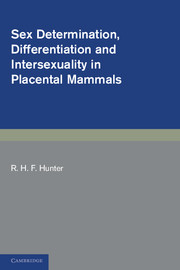Book contents
- Frontmatter
- Contents
- Preface
- Acknowledgements
- List of abbreviations
- List of gene abbreviations
- 1 Historical landmarks in studies of reproduction and sex determination
- 2 Mechanisms of sex determination
- 3 Differentiation of the gonads
- 4 Differentiation of the genital duct system
- 5 Anomalous sexual development in domestic species
- 6 Abnormal sexual development in laboratory rodents
- 7 Abnormal sexual development in man
- 8 Sexual differentiation in chimaeras
- 9 Asymmetries in the reproductive system and their significance
- 10 Concluding thoughts and a current perspective
- Index
- Plate section
4 - Differentiation of the genital duct system
Published online by Cambridge University Press: 05 March 2012
- Frontmatter
- Contents
- Preface
- Acknowledgements
- List of abbreviations
- List of gene abbreviations
- 1 Historical landmarks in studies of reproduction and sex determination
- 2 Mechanisms of sex determination
- 3 Differentiation of the gonads
- 4 Differentiation of the genital duct system
- 5 Anomalous sexual development in domestic species
- 6 Abnormal sexual development in laboratory rodents
- 7 Abnormal sexual development in man
- 8 Sexual differentiation in chimaeras
- 9 Asymmetries in the reproductive system and their significance
- 10 Concluding thoughts and a current perspective
- Index
- Plate section
Summary
Introduction
The comments that follow are intended to summarise some of the key events taking place during normal differentiation of the reproductive tracts in eutherian mammals rather than presenting an exhaustive description. Comprehensive reviews of the topic or essays containing important detail include those of Jost (1947, 1961, 1970), Burns (1961), Price, Zaaijer & Ortiz (1969), Josso, Picard & Tran (1977), Byskov (1978, 1986), Wilson (1978), Josso (1981), Short (1982), Josso & Picard (1986) and Byskov & Høyer (1988). Material in the major chapter by Glover, D'Occhio & Millar (1990) is also relevant.
The embryological derivation of male or female reproductive tracts is the principal theme of this chapter; further growth of the tracts up to the time of puberty and the nature of underlying endocrine factors are considered only in passing. Whilst elaboration of a distinct duct system characteristic of a male or a female is the usual sequel to gonadal differentiation, portions of both male and female duct systems may be preserved and indeed become prominent in conditions of intersexuality. In other words, perturbations in gonadal development – such as formation of an ovotestis – may find expression in the morphology of the genital tract. Only exceptionally, however, is partial or extensive duplication of the genital systems in mature animals not correlated with some form of anomalous development of one or both gonads.
Duplication of ducts: genetic inferences
Quite apart from a demonstrable plasticity in the gonadal tissues in the form of their development, the embryonic duct system can also be viewed as bipotential in that it is duplicated during the initial stages of organogenesis.
- Type
- Chapter
- Information
- Publisher: Cambridge University PressPrint publication year: 1995
- 1
- Cited by

